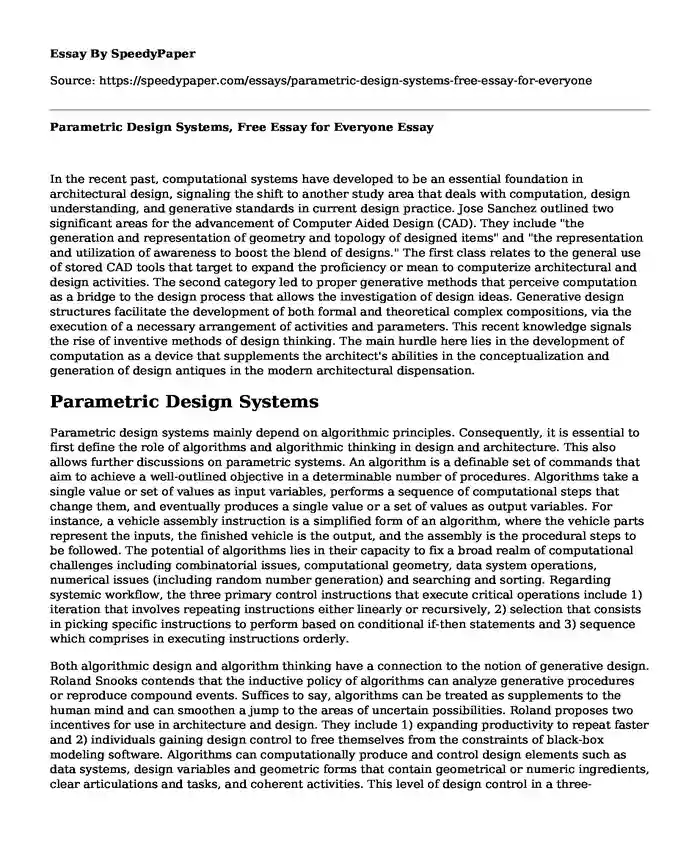
| Type of paper: | Case study |
| Categories: | Software Architecture Design |
| Pages: | 3 |
| Wordcount: | 817 words |
In the recent past, computational systems have developed to be an essential foundation in architectural design, signaling the shift to another study area that deals with computation, design understanding, and generative standards in current design practice. Jose Sanchez outlined two significant areas for the advancement of Computer Aided Design (CAD). They include "the generation and representation of geometry and topology of designed items" and "the representation and utilization of awareness to boost the blend of designs." The first class relates to the general use of stored CAD tools that target to expand the proficiency or mean to computerize architectural and design activities. The second category led to proper generative methods that perceive computation as a bridge to the design process that allows the investigation of design ideas. Generative design structures facilitate the development of both formal and theoretical complex compositions, via the execution of a necessary arrangement of activities and parameters. This recent knowledge signals the rise of inventive methods of design thinking. The main hurdle here lies in the development of computation as a device that supplements the architect's abilities in the conceptualization and generation of design antiques in the modern architectural dispensation.
Parametric Design Systems
Parametric design systems mainly depend on algorithmic principles. Consequently, it is essential to first define the role of algorithms and algorithmic thinking in design and architecture. This also allows further discussions on parametric systems. An algorithm is a definable set of commands that aim to achieve a well-outlined objective in a determinable number of procedures. Algorithms take a single value or set of values as input variables, performs a sequence of computational steps that change them, and eventually produces a single value or a set of values as output variables. For instance, a vehicle assembly instruction is a simplified form of an algorithm, where the vehicle parts represent the inputs, the finished vehicle is the output, and the assembly is the procedural steps to be followed. The potential of algorithms lies in their capacity to fix a broad realm of computational challenges including combinatorial issues, computational geometry, data system operations, numerical issues (including random number generation) and searching and sorting. Regarding systemic workflow, the three primary control instructions that execute critical operations include 1) iteration that involves repeating instructions either linearly or recursively, 2) selection that consists in picking specific instructions to perform based on conditional if-then statements and 3) sequence which comprises in executing instructions orderly.
Both algorithmic design and algorithm thinking have a connection to the notion of generative design. Roland Snooks contends that the inductive policy of algorithms can analyze generative procedures or reproduce compound events. Suffices to say, algorithms can be treated as supplements to the human mind and can smoothen a jump to the areas of uncertain possibilities. Roland proposes two incentives for use in architecture and design. They include 1) expanding productivity to repeat faster and 2) individuals gaining design control to free themselves from the constraints of black-box modeling software. Algorithms can computationally produce and control design elements such as data systems, design variables and geometric forms that contain geometrical or numeric ingredients, clear articulations and tasks, and coherent activities. This level of design control in a three-dimensional modeling environment permits the architects or in this case engineers to expand usefulness or access specific situations and react adequately. Consequently, an algorithm can successfully manage the difficulties of design far past form with accuracy and transform them into structural properties.
Parametric design is a sub-group of algorithmic composition and is entirely based on algorithmic development. Computationally, both algorithmic and parametric systems are similar. Algorithms follow parametric commands, and a parameter's structure crucial element is the algorithm. Nonetheless, as opposed to an algorithmic design, a parametric structure underscores the direct control of parameter values to trigger new design artifacts. This difference between the algorithmic and the parametric model is only evident in the design process, where the parameter values are altered by the architect to control the design geometry in search of the final design approach.
In conclusion, different types of interactive simulation and, assessment devices, combined with access to advanced manufacture innovations, empowers a quickened age, assessment and adjustment process in early design investigation. This commonly educated sophisticated material input circle makes it conceivable to create intense material instinct quickly. Uplifted material comprehension can, this way, encourage new sorts of compositional frameworks and emergence methodologies which could prompt better utilization of available assets, more imaginative design and a more grounded bond between aim and result through more streamlined design to generation forms.
Bibliography
Pall, S., & Hess, B. (2013). A flexible algorithm for calculating pair interactions on SIMD architectures. Computer Physics Communications, 184(12), 2641-2650.
Sanchez-Lopez, J. L., Pestana, J., de la Puente, P., & Campoy, P. (2016). A reliable open-source system architecture for the fast designing and prototyping of autonomous multi-UAV systems: Simulation and experimentation. Journal of Intelligent & Robotic Systems, 84(1-4), 779-797.
Snooks, R. (2014). Behavioral formation: multi-agent algorithmic design strategies.
Cite this page
Parametric Design Systems, Free Essay for Everyone. (2022, Jul 25). Retrieved from https://speedypaper.com/essays/parametric-design-systems-free-essay-for-everyone
Request Removal
If you are the original author of this essay and no longer wish to have it published on the SpeedyPaper website, please click below to request its removal:
Popular categories




